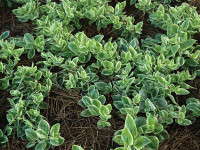Are “Weird” Plants Part Of the Future?

Life used to be less complicated a few decades ago, didn’t it? Remember those prehistoric times when the supposed time-saving technologies of Internet, e-mail, Blackberries and digital cameras were not as commonplace as smog? And in the landscape and garden center arenas, have you not watched the lava flow of vegetative annuals wash over the simple days of traditional bedding plants?
The lava flow was necessary. We needed more than one more marigold, we needed a lobelia that could live in temperatures higher than 65ËšF, and yes, we needed the beauty of plants like calibrachoa and argyranthemum, even though we still can’t pronounce them. Everyone is richer for the new material that fills the containers, baskets and parks in North America. But, geez Louise, are we scaring people with some of the more unusual material we are putting out there? Some might even call them weird. Remembering clearly that bacopa and angelonia were really weird not so long ago, here are a few of my choices for the weird and potentially wonderful plants for today and tomorrow. There are many others, so feel free to send me your scary choices.
Dorotheanthus
We trialed this plant (‘Mezoo Trailing Red’) last year and I figured it would either be (a) really slow and useless in a month or two or (b) really dead and useless in a month or two. With its succulent leaves and small flowers, I had trouble understanding why anyone would go to the trouble of looking at this as a potential new plant. However, we were pleasantly surprised by its rugged good looks, but more importantly, by its rugged performance in a summer that whipped the rear ends of many other well-known entries in the garden.
On the *Armi weird scale, it rates a 4 out of 5; on our performance scale, 4 out of 5.
Goodenia
This native of Australia has been bouncing around for a few years and has been touted as an excellent plant for dry summers in places like southern California and the Southwest. Although similar to scaevola in habit (it is in the same family), it has not yet shown me the vigor of scaevola either in Australia or over here. However, I notice breeder interest resurfacing, so perhaps this wonderfully weird yellow flowering groundcover may become another bacopa. I don’t hold out much hope, but I don’t live in southern California.
Armi weird scale, 4 out of 5; performance scale, 2 out of 5.
Chrysocephalum
This Australian native appeared as golden buttons a half dozen years ago, and it was embraced and ignored by landscapers and garden centers equally. Actually, it was ignored more. The plants produce green to gray foliage and small button-like yellow toy golden flowers, depending on the selection. It does not catch your eye in the container, and it looks a little, well, weird. However, having trialed this plant for a number of years, its weirdness is more than offset by its performance (Flambe looks good), particularly under stressful conditions of heat and drought. As our landscapes become more challenging, this plant should be mainstreamed.
Armi weird scale, 3 out of 5; performance scale, 4 out of 5.
Iochroma
When we first brought some of these plants into the garden a couple of years ago, I was transported to the Mediterranean where I first saw them. The wide green leaves and the thin trumpet-like flowers are truly eye-catching. It is a large shrub in its native habit, just like the poinsettia, and that likely kept it out of greenhouses for some time. However, in our garden, we trialed a number of forms, and one or two were outstanding in habit, flower power and performance. Newer selections are quickly finding their way into quirky greenhouses and mainstreaming has already begun. Already a half dozen cultivars are being tentatively offered and I expect to see demand skyrocket as improvements are made in the next couple of years.
Armi weird scale, 3 out of 5; performance scale, 4 out of 5.
Anagalis
Many years ago, we trialed seed material of pimpernel and beautiful as it was in northern Europe, it did terribly in our more stressful environments. Most breeders essentially gave up on it, as did I, so we were surprised to see it return to trials last year. Under the Angie banner, ‘Angie Blue’ and ‘Angie Orange’ attracted lots of attention by being very different from most other low growers, and having remarkably vivid and handsome flowers. When I left in early July for a sabbatical, plants still looked good and I was applauding the breeder. Unfortunately, as the summer became more difficult, poor old Angie put her hand to her head, and keeled over dead. However, when she was present, she was magnificent. I hope that the improvements we saw this year will continue, but she isn’t ready for the big party quite yet.
Armi weird scale, 3 out of 5; performance scale, 2 out of 5.
Pennisetum
Grasses have made a mark on our range of annuals in the last few years. Grasses became un-weird because of the perennial miscanthus cultivars and other mainstream hardy grasses. However, the annual purple pennisetum (P. setaceum) gave way to more “out there” forms like ‘Jester’ (P. glaucum, millet), with handsome two-toned foliage and a good flowering habit. However, grasses are still scary to many flower growers, even though grass-like plants, like cordyline and phormium, are in great demand. The latest and even more unusual pennisetum is P. purpureum, which is being used for landscape wow factor and as phormium substitutes. Plants like ‘Prince’ and ‘Princess’ are the tip of the iceberg. I look for great improvements in the next few years.
Armi weird scale, 3 out of 5; performance scale, 5 out of 5.









